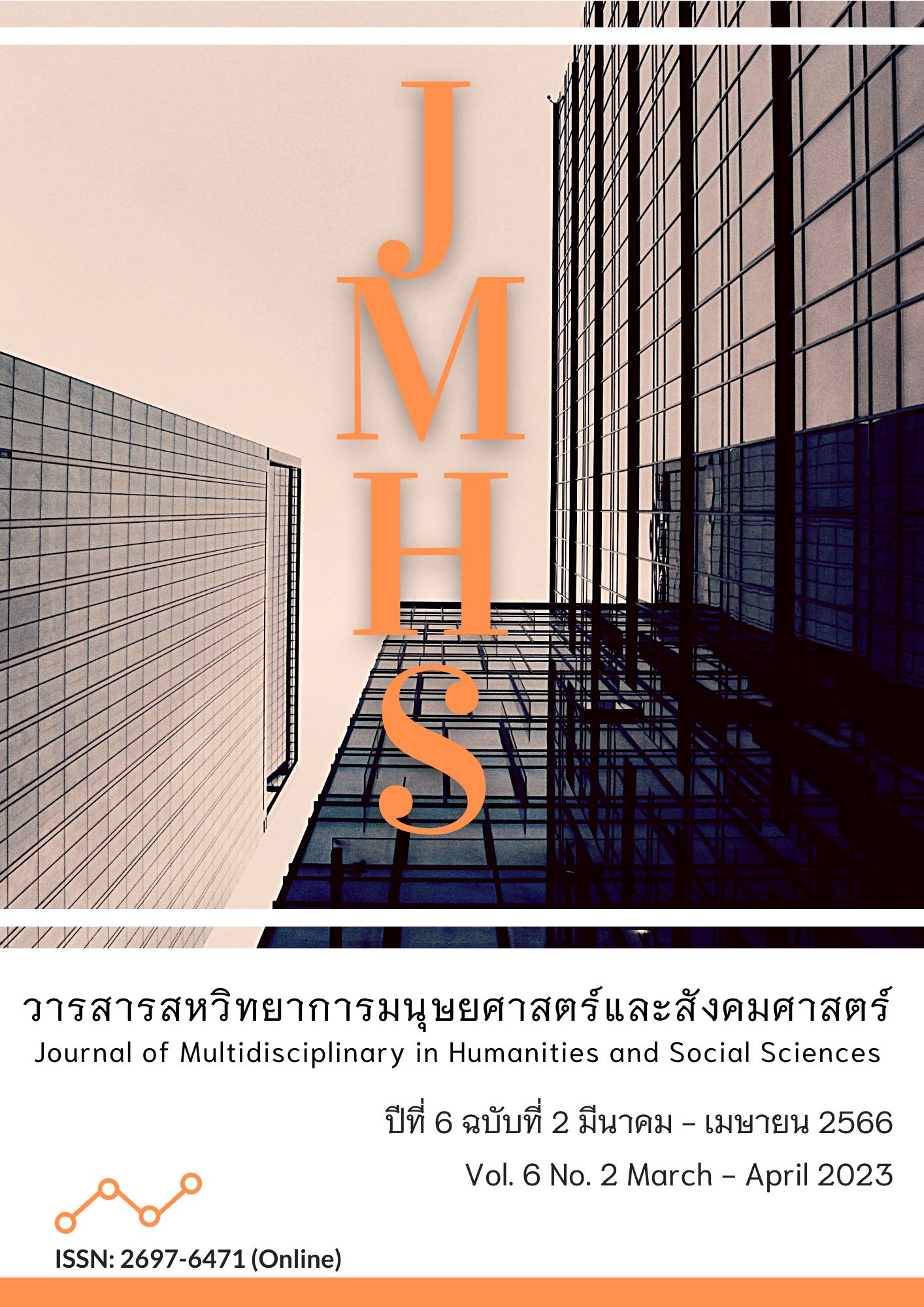The Development of Learning Activities by Using Design Thinking Process to Enhance Green Innovative Entrepreneurship Competency for Ninth Grade Students
Main Article Content
Abstract
This article aimed to (1) create and verify the effectiveness of learning activities using the design thinking process; (2) compare the green innovative entrepreneurship competency after using learning activities using the 70 criterion; (3) study the green innovative entrepreneurship competency level of students; and (4) study the opinions of students towards learning activities. This study was based on research and development methodology. The population was conducted with 33 students in the ninth grade at schools under the secondary educational service area office of Phitsanulok Uttaradit. They were selected by cluster random sampling. The research tools were (1) learning activities; (2) a competency assessment form; and (3) an after-action review form. The data were analyzed using the mean, percentage, standard deviation, T-test, and content analysis. The results of the study revealed that: 1. The learning activities using the design thinking process consisted of 5 steps. The result indicated appropriate quality with the highest level and efficiency at 75.12/75.46 which satisfied the 75/75 criterion. 2. Students were a green innovative entrepreneurship competency after learning was statistically significant higher than the 70 percent criteria at the .05 levels. 3. Students were a green innovative entrepreneurship competency at an advanced level and a developing level accounted for 72.73% and 27.27%, and 4. Students were motivated to produce green innovations, had the intention of being entrepreneurs, and were able to apply a variety of knowledge to change themselves in working to achieve success.
Article Details

This work is licensed under a Creative Commons Attribution-NonCommercial-NoDerivatives 4.0 International License.
Views and opinions appearing in the Journal it is the responsibility of the author of the article, and does not constitute the view and responsibility of the editorial team.
References
จักรกฤษณ์ จันทะคุณ. (2564). รายงานฉบับสมบูรณ์โครงการพัฒนาคุณภาพการศึกษาและพัฒนาท้องถิ่นโดยมีสถานบันอุดมศึกษาเป็นพี่เลี้ยง ปีงบประมาณ พ.ศ. 2564. สภางานการวิจัยแห่งชาติ.
ชัญญาภัค หล้าแหล่ง. (2558). ความสัมพันธ์เชิงสาเหตุและผลลัพธ์ของกลยุทธ์นวัตกรรมสีเขียว: หลักฐานเชิงประจักษ์ของธุรกิจอุตสาหกรรมการผลิตของไทยที่ได้รับการรับรองมาตรฐานสิ่งแวดล้อม ISO 14001.(วิทยานิพนธ์ปริญญาดุษฎีบัณฑิต), มหาวิทยาลัยศิลปากร.
ฐานิตดา นัดที. (2564). การจัดการเรียนรู้ตามแนวคิดสะตีมศึกษาด้วยกระบวนการคิดเชิงออกแบบเพื่อพัฒนาความสามารถในการสร้างสรรค์ผลงาน เรื่องวัสดุและการใช้ประโยชน์ สำหรับนักเรียนชั้นมัธยมศึกษาปีที่ 2. (วิทยาพินธ์ปริญญามหาบัณฑิต), มหาวิทยาลัยนเรศวร.
พิชชานันท์ ปานพรม. (2563). การพัฒนาการจัดการเรียนรู้ด้วยกระบวนการคิดเชิงออกแบบ เพื่อส่งเสริมความคิดสร้างสรรค์ของนักเรียนอาชีวศึกษา เรื่องสารอาหารในชีวิตประจำวัน. (วิทยานิพนธ์ปริญญามหาบัณฑิต), มหาวิทยาลัยนเรศวร.
พิชญา กล้าหาญ. (2563). การพัฒนากิจกรรมการเรียนรู้ตามแนวคิดกระบวนการคิดเชิงออกแบบร่วมกับการจัดการเรียนรู้โดยใช้โครงงานเป็นฐาน เพื่อส่งเสริมความเป็นนวัตกรของนักเรียนชั้นมัธยมศึกษาปีที่ 4. (วิทยานิพนธ์ปริญญามหาบัณฑิต), มหาวิทยาลัยศิลปากร.
ภุชงค์ โรจน์แสงรัตน์ (2563). การพัฒนารูปแบบการสอนโดยใช้แนวคิดการคิดเชิงออกแบบเป็นฐานเพื่อสร้างสรรค์ผลงานที่ปรากฏอัตลักษณ์ไทยสำหรับนิสิตนักศึกษาระดับปริญญาบัณฑิต. วารสารครุศาสตร์ จุฬาลงกรณ์มหาวิทยาลัย, 46(3), 258-273.
รัตนะ บัวสนธ์. (2552). การวิจัยและพัฒนานวัตกรรมการศึกษา. กรุงเทพฯ: คำสมัย.
สุภาภรณ์ โตโสภณ และ วารีรีตน์ แก้วอุไร. (2563). การพัฒนาหลักสูตรเสริมสร้างสมรรถนะการเป็นผู้ประกอบการ ตามแนวคิดการฝึกทางปัญหาจากต้นแบบ สำหรับนักศึกษาระดับประกาศนียบัตรวิชาชีพชั้นสูง. วารสารศึกษาศาสตร์ มหาวิทยาลัยนเรศวร, 22(2), 275-289.
สุมิตรา บูชา. (2563). การพัฒนากิจกรรมการเรียนรู้รายวิชาชีววิทยาโดยใช้การคิดเชิงออกแบบร่วมกับแนวคิดการเรียนรู้แบบมีส่วนร่วม เพื่อส่งเสริมความคิดสร้างสรรค์ของนักเรียนชั้นมัธยมศึกษาปีที่ 5. วารสารมหาจุฬานาครทรรศน์, 7(12), 210-221.
สำนักงานเลขาธิการสภาการศึกษา. (2564). แนวทางการพัฒนาสมรรถนะหลักของผู้เรียนระดับการศึกษาขั้นพื้นฐาน ในช่วงเปลี่ยนผ่านสู่หลักสูตรฐานสมรรถนะ. กรุงเทพฯ: กระทรวงศึกษาธิการ.
Brown, T. (2008). Design Thinking. Harvard Business Review, 86, 84-92.
Charter, M., & Clark, T. (2007). Sustainable Innovation: Key conclusions from Sustainable Innovation Conferences 2003-2006 Organised by The Centre for Sustainable Design. The Centre for Sustainable Design University College for the Creative Arts.
Choueiri, L. S., & Mhanna, S. (2013). The Design Process as a Life Skill. Procedia-Social and Behavioral Sciences, 93, 925-929.
European Commission/EACEA/Eurydice. (2016). Entrepreneurship Education at School in Europe. Eurydice Report. Luxembourg: Publications Office of the European Union.
Johansson-Skoldberg, U., Woodilla, J., & Ceetinkaya, M. (2013). Design Thinking: Past, Present and Possible Futures. Creativity and Innovation Management, 121-146.
McClelland, D. C. (1973). Testing for Competence Rather than for “Intelligence”. American Psychologist, 28, 1-14.
Office of the Education Council. (2014). Thailand Education for All Monitoring Report 2013. Bangkok: Prigwan Graphic.
OECD. (2014). Education at a Glance 2014; OECD Indicators. Paris: OECD Publishing.
OECD. (2018). Education at a Glance 2018; OECD Indicators. Paris: OECD Publishing.
The Stanford d.school Bootcamp Bootleg. (2019, February 9). Design Thinking Bootcamp Bootleg. Retrieved May 17, 2021 from https://dschool.stanford.edu/resources/the-bootcamp-bootleg.


